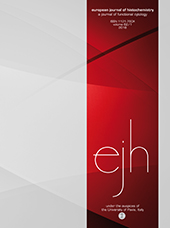RETRACTED: Neural stem cell conditioned medium alleviates Aβ25-35 damage to SH-SY5Y cells through the PCMT1/MST1 pathway

Submitted: 28 March 2020
Accepted: 29 May 2020
Published: 19 June 2020
Accepted: 29 May 2020
Abstract Views: 1123
PDF: 685
Publisher's note
All claims expressed in this article are solely those of the authors and do not necessarily represent those of their affiliated organizations, or those of the publisher, the editors and the reviewers. Any product that may be evaluated in this article or claim that may be made by its manufacturer is not guaranteed or endorsed by the publisher.
All claims expressed in this article are solely those of the authors and do not necessarily represent those of their affiliated organizations, or those of the publisher, the editors and the reviewers. Any product that may be evaluated in this article or claim that may be made by its manufacturer is not guaranteed or endorsed by the publisher.
Similar Articles
- CarloAlberto Redi, Transcription factors - Methods and protocols , European Journal of Histochemistry: Vol. 55 No. 1 (2011)
- Carlo Alberto Redi, Immunoelectron microscopy - Methods and protocols , European Journal of Histochemistry: Vol. 55 No. 3 (2011)
- J Sakurai, N Hattori, M Nakajima, T Moriya, T Suzuki, A Yokoyama, N Kohno, Differential expression of the glycosylated forms of MUC1 during lung development , European Journal of Histochemistry: Vol. 51 No. 2 (2007)
- Arianna Casini, Rosa Vaccaro, Mattia Toni, Carla Cioni, Distribution of choline acetyltransferase (ChAT) immunoreactivity in the brain of the teleost Cyprinus carpio , European Journal of Histochemistry: Vol. 62 No. 3 (2018)
- Roberto Ghiselli, Guendalina Lucarini, Monica Ortenzi, Eleonora Salvolini, Stefania Saccomanno, Fiorenza Orlando, Mauro Provinciali, Fabio Casciani, Mario Guerrieri, Anastomotic healing in a rat model of peritonitis after non-steroidal anti-inflammatory drug administration , European Journal of Histochemistry: Vol. 64 No. 1 (2020)
- L Benkoël, P Biagini, F Dodero, X De Lamballerie, P De Micco, A Chamlian, D Lombardo, Immunohistochemical detection of C-100 hepatitis C virus antigen in formaldehyde-fixed paraffin-embedded liver tissue. Correlation with serum, tissue and in situ RT-PCR results , European Journal of Histochemistry: Vol. 48 No. 2 (2004)
- M Hirose, A Sun, T Okubo, S Noriki, Y Imamura, M Fukuda, Detection of non-papillary, non-invasive transitional cell G1 carcinoma as revealed by increased DNA instability and other cancer markers , European Journal of Histochemistry: Vol. 49 No. 2 (2005)
- Wenqian Xie, Hong Liu, Qian Liu, Qiong Gao, Fuli Gao, Yingying Han, Zhengrong Yuan, Haolin Zhang, Qiang Weng, Seasonal expressions of prolactin, prolactin receptor and STAT5 in the scented glands of the male muskrats (Ondatra zibethicus) , European Journal of Histochemistry: Vol. 63 No. 1 (2019)
- M Biggiogera, What’s new in an old-fashioned journal of histochemistry? , European Journal of Histochemistry: Vol. 51 No. 4 (2007)
- P Taupin, Processing scarce biological samples for light and transmission electron microscopy , European Journal of Histochemistry: Vol. 52 No. 2 (2008)
<< < 89 90 91 92 93 94 95 96 97 98 > >>
You may also start an advanced similarity search for this article.

 https://doi.org/10.4081/ejh.2020.3135
https://doi.org/10.4081/ejh.2020.3135










